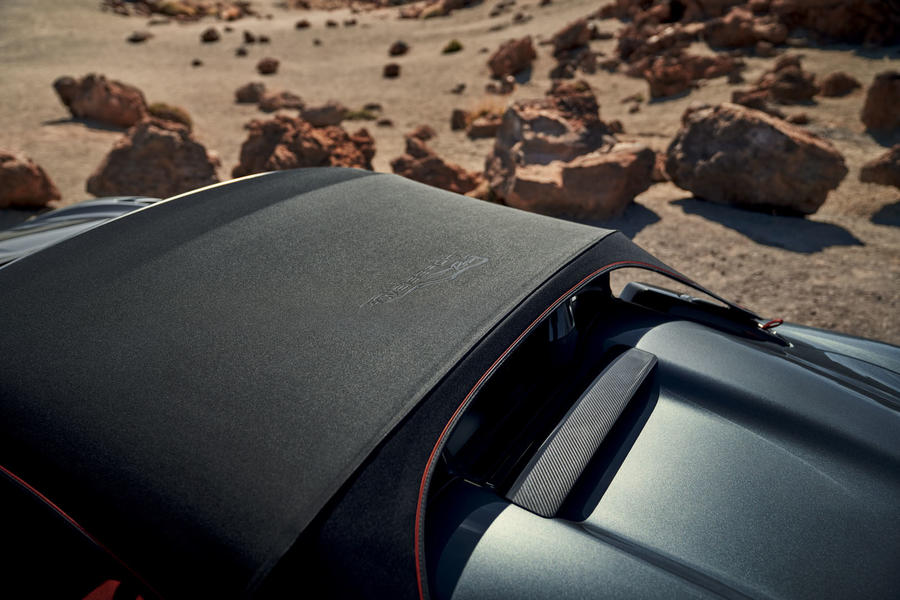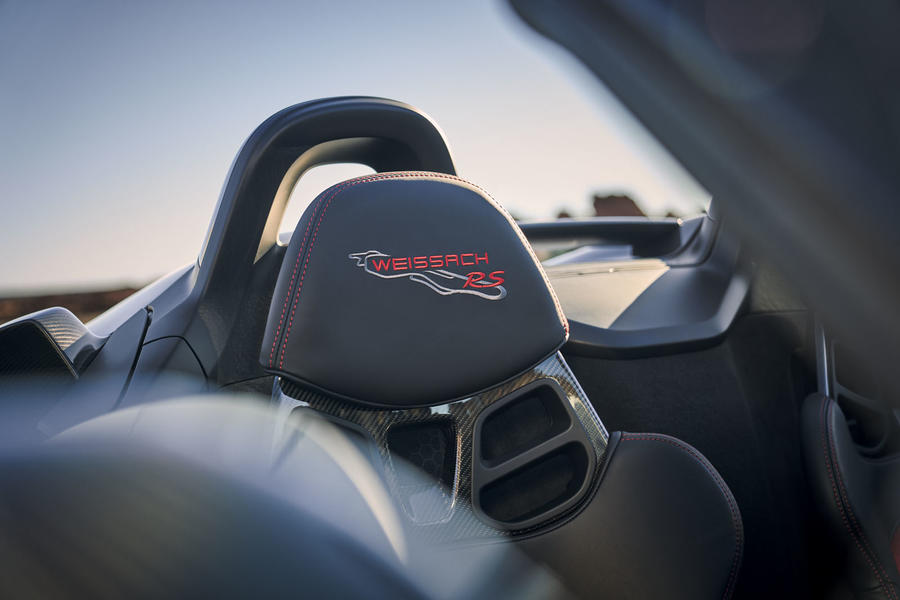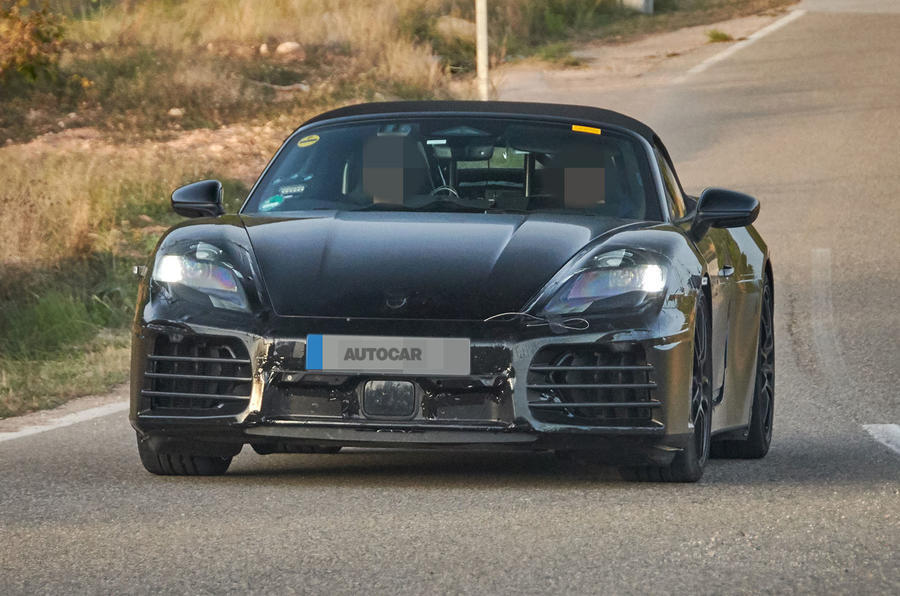The Porsche 718 Spyder GT4 RS has 350bhp per tonne, slightly more than the Cayman GT4 RS’s 348bhp per tonne
GT3 engine transplant marks the end of an era as the popular convertible is prepared for electrification
The new 718 Spyder GT4 RS is a screaming, drop-top swansong for Porsche’s mid-engined sports car family ahead of its transition to a pure-EV drivetrain in 2025.
The final iteration of the 718 – as we know it – is the most powerful derivative of the Boxster since production began in 1995. It takes 493bhp and 332lb ft from the same GT3-based atmo 4.0-litre flat six that powers its hard-top sibling, the five-star 718 Cayman GT4 RS. Redlining at an ear-splitting 9000rpm and sending its reserves through a “lightning-speed” seven-speed PDK gearbox, it propels the roadster from 0-62mph in just 3.4sec and on to 191mph.
Porsche says the open roof “makes the highly evocative sound of the engine an even more compelling experience”, particularly given the fitment of a lightweight stainless steel sports exhaust and new air intakes mounted just next to the headrests.
Below the beltline, the Spyder GT4 RS is visually almost identical to the hottest Cayman, complete with gaping air ducts, aggressive downforce-boosting addenda, carbonfibre-reinforced plastic (CFRP) bonnet and wings, and race-style 20in centre-locking forged alloy wheels.
“Designed for maximum pleasure on winding roads,” the car also brings the same track-honed chassis upgrade package as its hard-top sibling. Sitting 30mm closer to the ground on stiffer shocks, it is equipped as standard with Porsche’s active suspension management (PASM) system and features a corner-carving torque-vectoring package with a mechanical differential lock on the rear axle.
![]()
Up top, meanwhile, the RS takes its lead from the ‘standard’ (but barely less powerful) 718 Spyder in gaining a pair of distinctive buttresses on its rear deck and a prominent ‘ducktail’ rear wing in the name of enhanced aerodynamics.
The striking soft-top has been designed to incur an absolutely minimal weight penalty. Manually operated and made of a lightweight single-layer canvas, the entire structure – comprising a separate ‘sun sail’ and weather protector – weighs just 18.3kg, 7.6kg less than the non-RS Spyder’s and 16.5kg less than the standard Boxster’s. The canvas element can be stowed in the car or removed entirely to save 8kg on the move.
Porsche GT project manager Markus Atz told Autocar that the familiar styling belies the amount of work that went into refining the Spyder GT4 RS’s roof. He said: “If you reduce it to a few words, it’s just the open version of the GT4 RS. In detail, there was much more to do. We had to look at how we could have a soft-top on the car together with the intake system of the GT4 RS.

“Because of the transplant of the GT3 engine, we had no other choice than to use the same airbox, but the airbox is directly in the space where the roof is fitted while retracted.
“So there was not enough room for the roof from the base Spyder… So we had a big problem to introduce a new roof just for this car. But after having these problems, we wanted to do the best out of the necessity.”
All up, the Spyder GT4 RS tips the scales at 1410kg – 40kg lighter than the non-RS car – for a power-to-weight ratio of 350bhp per tonne, very slightly up on the Cayman’s 348bhp.
The focus on shaving every kilogram possible extends to the cabin, where the seats are swapped for CFRP buckets upholstered in leather and microfibre, the door handles make way for pull straps and the steering wheel is swapped for a minimalist RS unit with the telltale ‘12 o’clock’ yellow marking.

Production numbers will not be strictly limited, and nor has Porsche put an end date on production of the new variant. UK pricing starts from £123,000, the same as the 718 Cayman GT4 RS.
Deliveries are scheduled to begin in July, following the car’s public debut at the Goodwood Festival of Speed.
Q&A: Markus Atz, project manager, Porsche GT cars

What reaction do you expect to the final ICE 718?
“I think it will be an instant classic because it’s the last combustion-engined 718 model line – and the pinnacle of it… Twenty-five years ago, the 986 Boxster started with 204hp. Now we have 500hp in the same package – nearly – as 25 years ago. So that was really good, and fast, development in 25 years.”
Why does it have to be the final ICE 718?
“Euro 7 sets in in mid-2025 and there was a decision of whether we would develop the engine according to the Euro 7 regulations, or change the model line to battery-electric drive. The 911 will stay with a combustion engine. And the 718 then, probably, is the battery-electric alternative, depending on the market.”
Is a 718 hybrid impossible?
“If you compare the package space for electrification, the 992 got an eight-gear PDK, where the room is already there to get an electric drive inside, and the 718 stayed with the seven-gear PDK, where there is no space left. It would have been possible to make a hybrid car out of the 718 successor, but the 992 will come at a certain time with hybrid systems, so it doesn’t make any real sense to have a second car with hybrid drive.”
When will the Porsche 718 exit the ICE age?

The electric Boxster is due in 2025, but Porsche has yet to set an end date for petrol 718 production. “We can’t communicate an exact date, because it’s not really fixed. The dates are different in different markets and there can always be changes,” said Markus Atz. “So if we said we will produce it until the end of 2026 and, say, the electric 718 was postponed by half a year, would we have to stop at the end of 2025 and create a gap? No.”
Source: Autocar
